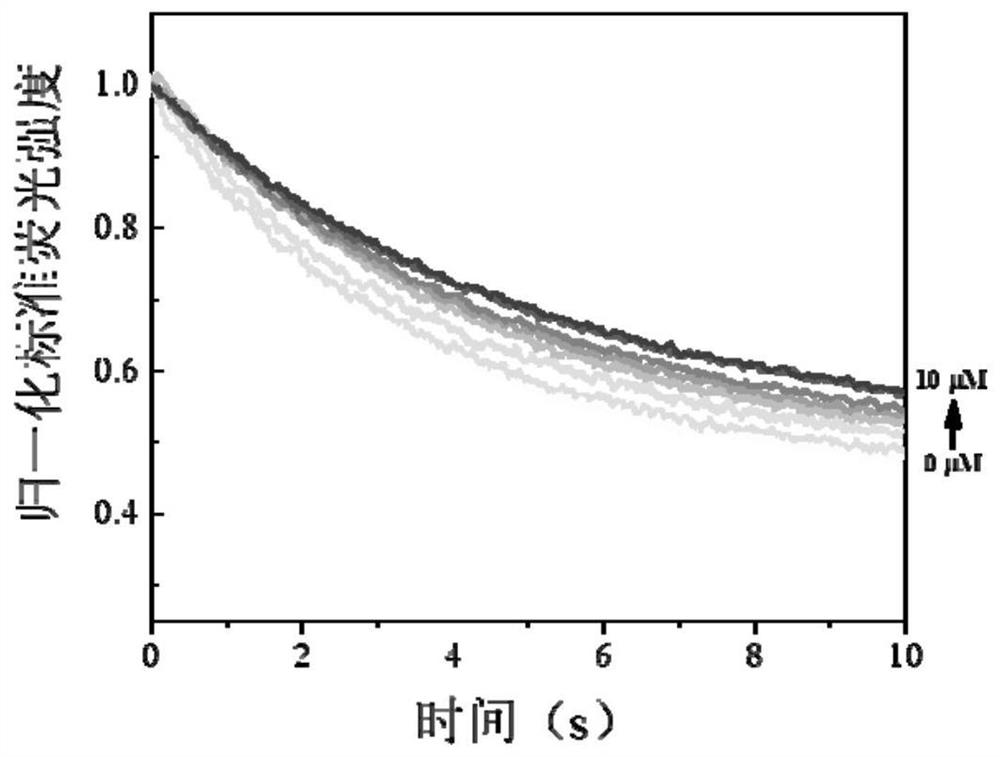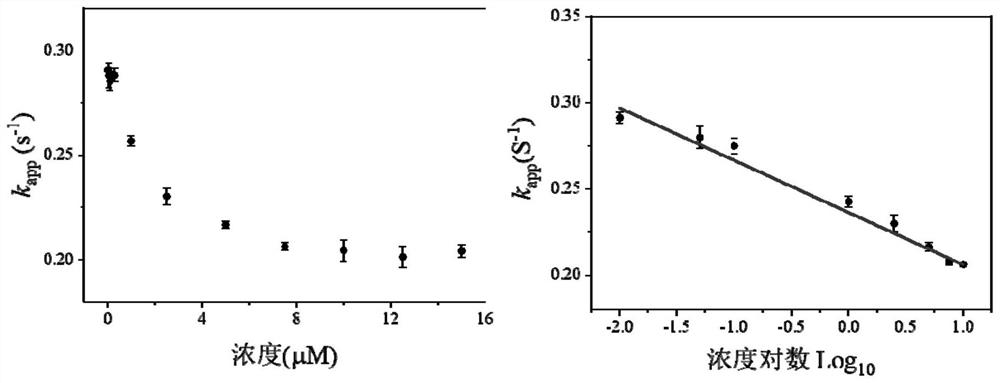Photoisomerization-based biosensor and application thereof in thrombin detection
A biosensor and photoisomerization technology, applied in the field of analysis and detection, can solve the problems of false positive test results, background fluorescence interference, complicated use of separation process, etc., achieve simple preparation and operation, realize recycling and regeneration, and have important academic and application prospects. Effect
- Summary
- Abstract
- Description
- Claims
- Application Information
AI Technical Summary
Problems solved by technology
Method used
Image
Examples
preparation example Construction
[0051] The preparation method of the above-mentioned photoisomerization-based biosensor comprises the following steps:
[0052] (A1) Select a stilbene compound with an active reactive group as a fluorescent signal molecule, and react with a thrombin aptamer modified by an active reactive group in a solution to form a fluorescent aptamer sensor to obtain a fluorescent aptamer sensor products;
[0053] (A2) Separating and purifying the fluorescent aptasensor solution in step (A1) to obtain a purified fluorescent aptasensor product.
[0054] Further, in the step (A1), the reaction ratio of the fluorescent signal molecule to the thrombin aptamer is 5-15mM: 50-150μM, preferably 10mM: 100μM; the reaction solvent is sodium bicarbonate buffer, pH 8 -10, the reaction conditions are under the condition of avoiding light, magnetic stirring for 11-13h, preferably 12h; the reaction temperature is 15-30°C, the reaction temperature can be 15°C, 25°C and 30°C, more preferably 30°C.
[0055...
Embodiment 1
[0071] (1) Preparation of fluorescent aptasensors
[0072] Weigh an appropriate amount of 4-acetylamino-4'-stilbene-isothiocyanate-2,2'-disulfonic acid disodium salt (SITS) solid powder, add a certain amount of ultrapure water to dissolve it into a 100mM solution, as stock solution. Take 10 μL of 100 mM SITS solution and add it to 90 μL of sodium bicarbonate (0.1 M, pH=9.8) buffer solution to dilute it to 10 mM, and prepare it immediately for use. With an appropriate amount of ultrapure water, the sequence was 5'-NH 2 -(CH 2 ) 6 The amino-modified thrombin aptamer of -GTCCGTGGTAGG GCAGGTTGGGGTGAC-3' was dissolved and diluted to 100 μM, aliquoted into 100 μL tubes, and stored at -20°C. Take 100 μL each of the above 10 mM SITS and 100 μM nucleic acid aptamer solutions in the same 2 mL centrifuge tube, and react for 12 h at 30 ° C, protected from light, and magnetically stirred. Take out the reaction solution and use an ultrafiltration centrifuge tube to use 1M NaCl solution...
Embodiment 2
[0081] In order to illustrate the specificity of the present invention, cytochrome C (Cyt C), fibrinogen (FIB), lysozyme (Lys) and T4 polynucleotide kinase (T4 PNK) were selected as interfering proteins for parallel interference detection . Prepare the above-mentioned three proteins except T4 polynucleotide kinase and thrombin as standard solutions with concentrations of 2 μM and 5 μM, and T4 polynucleotide kinase to 35 U·mL -1 and 89U·mL -1 standard solution. Detect concrete steps with reference to embodiment one; The result is as follows Figure 4 As shown, the apparent fluorescence decay rate k of the sensor after the interfering protein was added app It was similar to that of the blank group, but had obvious changes in the group added with thrombin. This result shows that the present invention has good specificity and specificity.
PUM
 Login to View More
Login to View More Abstract
Description
Claims
Application Information
 Login to View More
Login to View More - R&D
- Intellectual Property
- Life Sciences
- Materials
- Tech Scout
- Unparalleled Data Quality
- Higher Quality Content
- 60% Fewer Hallucinations
Browse by: Latest US Patents, China's latest patents, Technical Efficacy Thesaurus, Application Domain, Technology Topic, Popular Technical Reports.
© 2025 PatSnap. All rights reserved.Legal|Privacy policy|Modern Slavery Act Transparency Statement|Sitemap|About US| Contact US: help@patsnap.com



